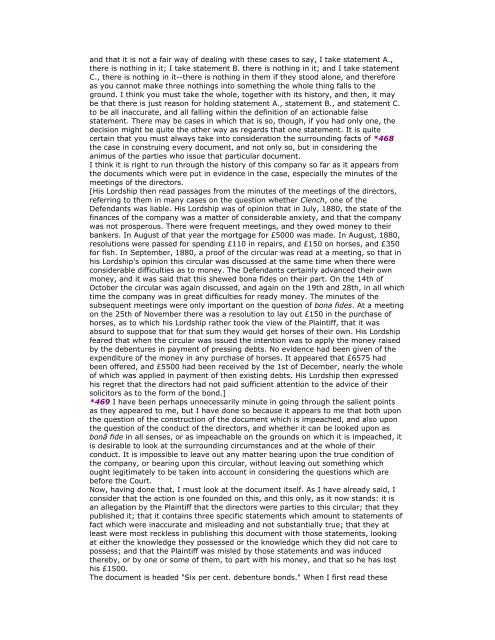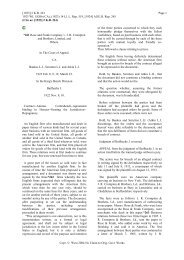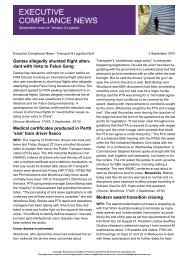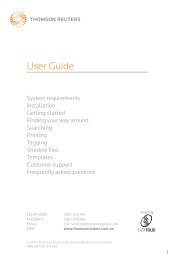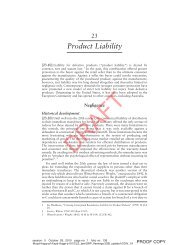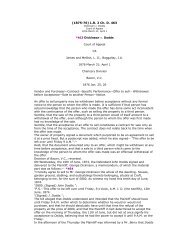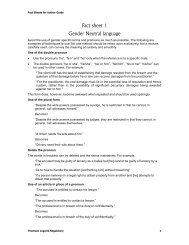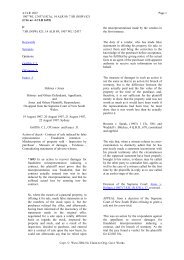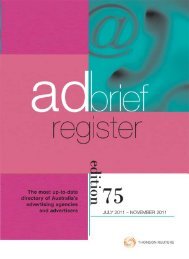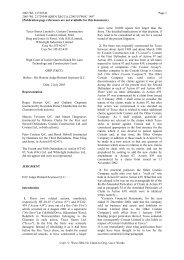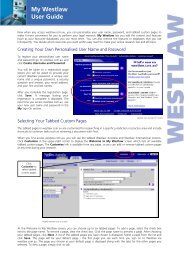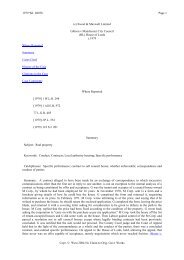Edington v Fitzmaurice - Thomson Reuters
Edington v Fitzmaurice - Thomson Reuters
Edington v Fitzmaurice - Thomson Reuters
You also want an ePaper? Increase the reach of your titles
YUMPU automatically turns print PDFs into web optimized ePapers that Google loves.
and that it is not a fair way of dealing with these cases to say, I take statement A.,there is nothing in it; I take statement B. there is nothing in it; and I take statementC., there is nothing in it--there is nothing in them if they stood alone, and thereforeas you cannot make three nothings into something the whole thing falls to theground. I think you must take the whole, together with its history, and then, it maybe that there is just reason for holding statement A., statement B., and statement C.to be all inaccurate, and all falling within the definition of an actionable falsestatement. There may be cases in which that is so, though, if you had only one, thedecision might be quite the other way as regards that one statement. It is quitecertain that you must always take into consideration the surrounding facts of *468the case in construing every document, and not only so, but in considering theanimus of the parties who issue that particular document.I think it is right to run through the history of this company so far as it appears fromthe documents which were put in evidence in the case, especially the minutes of themeetings of the directors.[His Lordship then read passages from the minutes of the meetings of the directors,referring to them in many cases on the question whether Clench, one of theDefendants was liable. His Lordship was of opinion that in July, 1880, the state of thefinances of the company was a matter of considerable anxiety, and that the companywas not prosperous. There were frequent meetings, and they owed money to theirbankers. In August of that year the mortgage for £5000 was made. In August, 1880,resolutions were passed for spending £110 in repairs, and £150 on horses, and £350for fish. In September, 1880, a proof of the circular was read at a meeting, so that inhis Lordship's opinion this circular was discussed at the same time when there wereconsiderable difficulties as to money. The Defendants certainly advanced their ownmoney, and it was said that this shewed bona fides on their part. On the 14th ofOctober the circular was again discussed, and again on the 19th and 28th, in all whichtime the company was in great difficulties for ready money. The minutes of thesubsequent meetings were only important on the question of bona fides. At a meetingon the 25th of November there was a resolution to lay out £150 in the purchase ofhorses, as to which his Lordship rather took the view of the Plaintiff, that it wasabsurd to suppose that for that sum they would get horses of their own. His Lordshipfeared that when the circular was issued the intention was to apply the money raisedby the debentures in payment of pressing debts. No evidence had been given of theexpenditure of the money in any purchase of horses. It appeared that £6575 hadbeen offered, and £5500 had been received by the 1st of December, nearly the wholeof which was applied in payment of then existing debts. His Lordship then expressedhis regret that the directors had not paid sufficient attention to the advice of theirsolicitors as to the form of the bond.]*469 I have been perhaps unnecessarily minute in going through the salient pointsas they appeared to me, but I have done so because it appears to me that both uponthe question of the construction of the document which is impeached, and also uponthe question of the conduct of the directors, and whether it can be looked upon asbonâ fide in all senses, or as impeachable on the grounds on which it is impeached, itis desirable to look at the surrounding circumstances and at the whole of theirconduct. It is impossible to leave out any matter bearing upon the true condition ofthe company, or bearing upon this circular, without leaving out something whichought legitimately to be taken into account in considering the questions which arebefore the Court.Now, having done that, I must look at the document itself. As I have already said, Iconsider that the action is one founded on this, and this only, as it now stands: it isan allegation by the Plaintiff that the directors were parties to this circular; that theypublished it; that it contains three specific statements which amount to statements offact which were inaccurate and misleading and not substantially true; that they atleast were most reckless in publishing this document with those statements, lookingat either the knowledge they possessed or the knowledge which they did not care topossess; and that the Plaintiff was misled by those statements and was inducedthereby, or by one or some of them, to part with his money, and that so he has losthis £1500.The document is headed "Six per cent. debenture bonds." When I first read these


